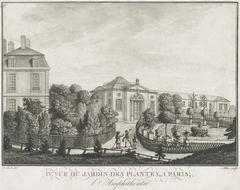
Hôtel de Magny Paris: Visiting Hours, Tickets, and Historical Site Guide
Date: 15/06/2025
Introduction
Nestled within the storied Jardin des Plantes in Paris’s 5th arrondissement, the Hôtel de Magny is a remarkable testament to French architectural refinement and Enlightenment-era scientific progress. Built between 1696 and 1700 by Pierre Bullet, this hôtel particulier embodies the elegance of classical Parisian design and has played a pivotal role in the intellectual life of the city, especially as the administrative heart of the Muséum national d’Histoire naturelle (Sortir à Paris, Paris Promeneurs). Though it primarily serves administrative functions today and is not typically open to the public, the Hôtel de Magny occasionally opens its doors for special events, offering rare glimpses into its architectural grandeur and scientific heritage (France Info). This guide provides a detailed overview of the site’s history, architecture, visiting logistics, and tips for making the most of your experience.
Table of Contents
- Introduction
- Historical Overview and Evolution
- Architectural Features and Context
- Notable Residents and Scientific Legacy
- Heritage Status and Conservation
- Visitor Information: Hours, Tickets & Access
- What to Expect: Highlights and Tips
- Nearby Attractions and Amenities
- Frequently Asked Questions (FAQ)
- Summary and Recommendations
- References
Historical Overview and Evolution
Origins and Construction
Commissioned by Foucault de Magny and constructed by Pierre Bullet between 1696 and 1700, the Hôtel de Magny was originally conceived as a private aristocratic residence. Its location, between the Jardin royal des plantes médicinales (now the Jardin des Plantes) and the Abbey Saint-Victor, positioned it at the crossroads of Parisian intellectual and social life (Sortir à Paris).
Transition to Scientific Hub
In 1787, the property was acquired by Count Georges-Louis Leclerc de Buffon, a preeminent naturalist and intendant of the Jardin des Plantes. Under Buffon’s direction, the building became the administrative and scientific nexus of the Muséum national d’Histoire naturelle, hosting a range of influential figures and pivotal discussions in natural history (Paris Promeneurs).
Modern Use and Exhibition Space
Throughout the 19th and 20th centuries, the Hôtel de Magny was fully integrated into the museum’s administration. Between 2008 and 2017, it housed the Cabinet d’Histoire du Jardin des Plantes, an exhibition space dedicated to the site’s and the museum’s history.
Architectural Features and Context
Parisian Hôtel Particulier Tradition
The Hôtel de Magny epitomizes the Parisian hôtel particulier—grand urban residences designed for nobility and the affluent bourgeoisie. These structures typically include a stately façade, a formal courtyard, and private gardens, reflecting both social aspirations and the urban fabric of Paris (Paris Buildings: A Brief History).
Stylistic Influences
- Façade: Classic symmetry, pilasters, and a central pediment echo Baroque and early Neoclassical sensibilities.
- Interior: Though not generally accessible, the interior historically featured grand staircases, salons in enfilade, boiseries, and gilded moldings—hallmarks of refined Parisian taste (Britannica: Hôtel de Soubise).
- Technical Innovations: The building likely employs a Mansard roof and oeil-de-boeuf windows, maximizing living space and light.
Comparative Context
The Hôtel de Magny stands alongside other renowned hôtels particuliers, such as the Hôtel de Soubise and Hôtel de Matignon, as exemplars of Parisian urban elegance and innovation (Paris Buildings: A Brief History).
Notable Residents and Scientific Legacy
Prominent figures who shaped the sciences were associated with the Hôtel de Magny, including:
- Georges-Louis Leclerc de Buffon: Instrumental in transforming the Jardin des Plantes into a public research and educational space.
- Georges Cuvier, Étienne Geoffroy Saint-Hilaire, and Jean-Baptiste de Lamarck: Their work in paleontology, evolutionary theory, and taxonomy was deeply tied to the intellectual environment fostered here (Paris Promeneurs).
Heritage Status and Conservation
Monument Historique
The Hôtel de Magny has been classified as a Monument Historique since 1993, recognizing its architectural and scientific significance.
Restoration Efforts
Ongoing restoration campaigns, notably in partnership with the Fondation du Patrimoine, aim to address issues such as water infiltration and façade deterioration, securing the building’s future for continued scholarly and public engagement (France Info).
Visitor Information: Hours, Tickets & Access
Current Access Policy
- Regular Opening: The Hôtel de Magny is generally not open for unscheduled public visits. Its primary function is administrative.
- Special Events: Occasional access is granted during heritage days (Journées du Patrimoine) or special tours announced on the Muséum’s and Fondation du Patrimoine’s websites (Muséum national d’Histoire naturelle, Fondation du Patrimoine).
- Appointments: Administrative visits and group tours require prior arrangement.
Tickets
- General Admission: Not available for casual visits; special event tickets may be required when access is offered.
- Prices: Typically around €5 for adults during special exhibitions, with discounts for students and seniors; free for children under 18.
Accessibility
- The Jardin des Plantes is largely accessible, though the Hôtel de Magny’s interior accessibility depends on event arrangements.
- Audio guides and multilingual information may be available during special events.
Getting There
- Location: Western edge of the Jardin des Plantes, 5th arrondissement, Paris.
- Nearest Metro: Gare d’Austerlitz (Lines 5, 10), Jussieu (Lines 7, 10).
- Buses: Multiple routes serve the area.
- Parking: Limited; public transport is recommended.
What to Expect: Highlights and Tips
Exterior Viewing
Visitors to the Jardin des Plantes can admire the Hôtel de Magny’s elegant façade and classic lines from public areas. The building’s north face, with its central pediment and balanced proportions, is particularly photogenic (Paris Historique).
Special Features
- Salons d’Honneur: Ceremonial salons and a historic model of the Jardin des Plantes may be accessible during rare open days.
- Historic Quarries: The building’s basement offers access (by special arrangement) to medieval limestone quarries once supplying stone for Paris landmarks.
Visitor Tips
- Check Official Sources: Before your visit, consult the Muséum’s and Fondation du Patrimoine’s websites for up-to-date information on special openings, restoration work, and ticketing.
- Combine with Nearby Attractions: The Jardin des Plantes offers museums, gardens, and the Ménagerie zoo for a full day’s exploration.
Nearby Attractions and Amenities
- Grande Galerie de l’Évolution: A major natural history museum adjacent to the Hôtel de Magny.
- Ménagerie, le zoo du Jardin des Plantes: Family-friendly historic zoo.
- Amphithéâtre Verniquet: An architectural gem within the garden complex.
- Cafés and Dining: Onsite and nearby options in the Latin Quarter.
- Accommodation: A wide selection of hotels in the 5th arrondissement and Latin Quarter (Easy Travel 4U).
Frequently Asked Questions (FAQ)
Q: Can I visit the Hôtel de Magny without an appointment?
A: No, regular access is restricted; only special events or appointments allow entry.
Q: When are special tours or open days held?
A: Usually during European Heritage Days or as announced by the Muséum national d’Histoire naturelle.
Q: Are tickets required for special events?
A: Yes, when open for tours, tickets are typically required.
Q: Is the Hôtel de Magny accessible?
A: The Jardin des Plantes is accessible, but interior access depends on the event; confirm in advance.
Q: Can I take photos?
A: Exterior photography from the garden is allowed.
Summary and Recommendations
The Hôtel de Magny is a distinguished Parisian landmark, embodying the intersection of Enlightenment science and architectural refinement. Although not routinely open to the public, its exterior can be admired year-round, and special events offer rare chances to explore its historical interiors. Restoration initiatives underscore its enduring significance. Visitors are encouraged to monitor official channels for updates, incorporate the site into a broader Jardin des Plantes itinerary, and enhance their visit with digital resources like the Audiala app (Muséum national d’Histoire naturelle, Fondation du Patrimoine).
References
- Sortir à Paris Article
- Paris Promeneurs Guide
- France Info on Restoration
- Paris Buildings: A Brief History
- Muséum national d’Histoire naturelle Official Website
- Fondation du Patrimoine Official Website
- Paris Historique
- Wikipedia – Hôtel de Magny
- Paris Map 360
- Easy Travel 4U
- Travel Hotel Expert
- Make Time to See the World
- Britannica: Hôtel de Soubise






































































































































































































































